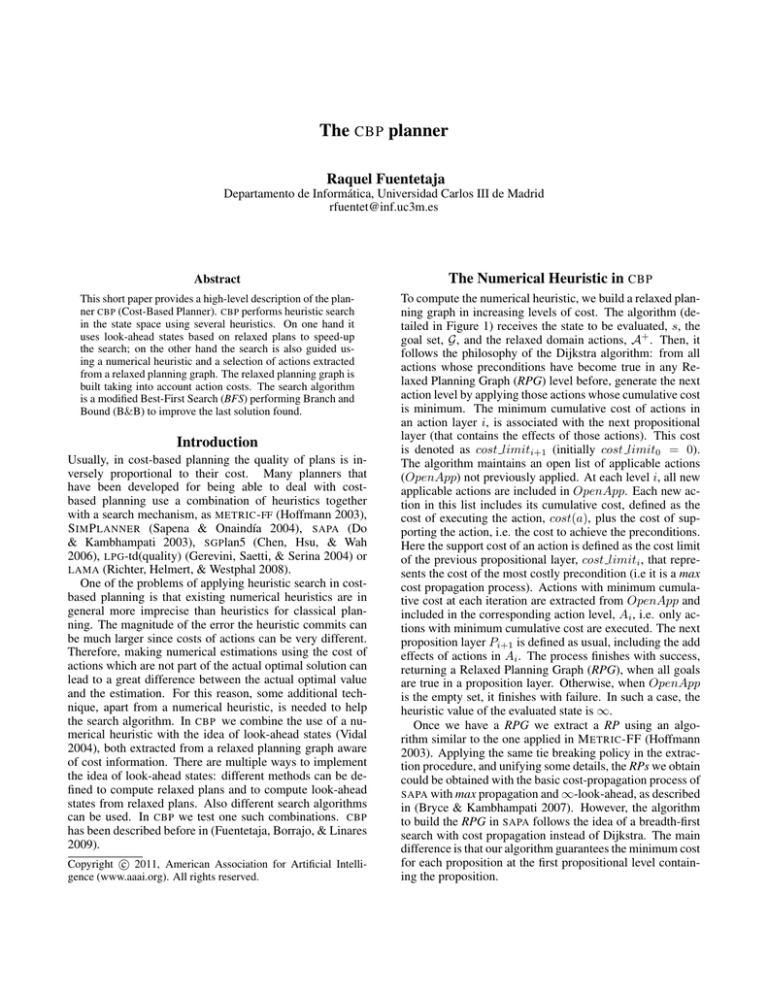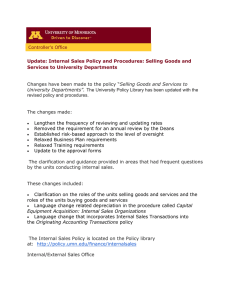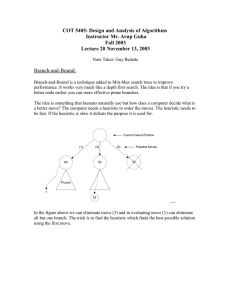
The CBP planner
Raquel Fuentetaja
Departamento de Informática, Universidad Carlos III de Madrid
rfuentet@inf.uc3m.es
Abstract
The Numerical Heuristic in CBP
This short paper provides a high-level description of the planner CBP (Cost-Based Planner). CBP performs heuristic search
in the state space using several heuristics. On one hand it
uses look-ahead states based on relaxed plans to speed-up
the search; on the other hand the search is also guided using a numerical heuristic and a selection of actions extracted
from a relaxed planning graph. The relaxed planning graph is
built taking into account action costs. The search algorithm
is a modified Best-First Search (BFS) performing Branch and
Bound (B&B) to improve the last solution found.
To compute the numerical heuristic, we build a relaxed planning graph in increasing levels of cost. The algorithm (detailed in Figure 1) receives the state to be evaluated, s, the
goal set, G, and the relaxed domain actions, A+ . Then, it
follows the philosophy of the Dijkstra algorithm: from all
actions whose preconditions have become true in any Relaxed Planning Graph (RPG) level before, generate the next
action level by applying those actions whose cumulative cost
is minimum. The minimum cumulative cost of actions in
an action layer i, is associated with the next propositional
layer (that contains the effects of those actions). This cost
is denoted as cost limiti+1 (initially cost limit0 = 0).
The algorithm maintains an open list of applicable actions
(OpenApp) not previously applied. At each level i, all new
applicable actions are included in OpenApp. Each new action in this list includes its cumulative cost, defined as the
cost of executing the action, cost(a), plus the cost of supporting the action, i.e. the cost to achieve the preconditions.
Here the support cost of an action is defined as the cost limit
of the previous propositional layer, cost limiti , that represents the cost of the most costly precondition (i.e it is a max
cost propagation process). Actions with minimum cumulative cost at each iteration are extracted from OpenApp and
included in the corresponding action level, Ai , i.e. only actions with minimum cumulative cost are executed. The next
proposition layer Pi+1 is defined as usual, including the add
effects of actions in Ai . The process finishes with success,
returning a Relaxed Planning Graph (RPG), when all goals
are true in a proposition layer. Otherwise, when OpenApp
is the empty set, it finishes with failure. In such a case, the
heuristic value of the evaluated state is ∞.
Once we have a RPG we extract a RP using an algorithm similar to the one applied in M ETRIC -FF (Hoffmann
2003). Applying the same tie breaking policy in the extraction procedure, and unifying some details, the RPs we obtain
could be obtained with the basic cost-propagation process of
SAPA with max propagation and ∞-look-ahead, as described
in (Bryce & Kambhampati 2007). However, the algorithm
to build the RPG in SAPA follows the idea of a breadth-first
search with cost propagation instead of Dijkstra. The main
difference is that our algorithm guarantees the minimum cost
for each proposition at the first propositional level containing the proposition.
Introduction
Usually, in cost-based planning the quality of plans is inversely proportional to their cost. Many planners that
have been developed for being able to deal with costbased planning use a combination of heuristics together
with a search mechanism, as METRIC - FF (Hoffmann 2003),
S IM P LANNER (Sapena & Onaindı́a 2004), SAPA (Do
& Kambhampati 2003), SGPlan5 (Chen, Hsu, & Wah
2006), LPG-td(quality) (Gerevini, Saetti, & Serina 2004) or
LAMA (Richter, Helmert, & Westphal 2008).
One of the problems of applying heuristic search in costbased planning is that existing numerical heuristics are in
general more imprecise than heuristics for classical planning. The magnitude of the error the heuristic commits can
be much larger since costs of actions can be very different.
Therefore, making numerical estimations using the cost of
actions which are not part of the actual optimal solution can
lead to a great difference between the actual optimal value
and the estimation. For this reason, some additional technique, apart from a numerical heuristic, is needed to help
the search algorithm. In CBP we combine the use of a numerical heuristic with the idea of look-ahead states (Vidal
2004), both extracted from a relaxed planning graph aware
of cost information. There are multiple ways to implement
the idea of look-ahead states: different methods can be defined to compute relaxed plans and to compute look-ahead
states from relaxed plans. Also different search algorithms
can be used. In CBP we test one such combinations. CBP
has been described before in (Fuentetaja, Borrajo, & Linares
2009).
c 2011, American Association for Artificial IntelliCopyright gence (www.aaai.org). All rights reserved.
function compute RPG hlevel (s, G, A+ )
let i = 0; P0 = s; OpenApp = ∅; cost limit0 = 0;
while G * Pi do
OpenApp = OpenApp ∪ a ∈ A+ \ ∪ Aj | pre(a) ⊆ Pi
j<i
forall new action in OpenApp do
cum
cost(a) = cost(a) + cost limit
i
Ai = a | a ∈ arg min cum cost(a)
a∈OpenApp
cost limiti+1 =
min
a∈OpenApp
cum cost(a)
Pi+1 = Pi ∪ add(a)
a∈Ai
if OpenApp = ∅ then return fail
OpenApp = OpenApp \ Ai
i=i+1
return P0 , A0 , P1 , ..., Pi−1 , Ai−1 , Pi
Figure 1: Algorithm for building the RPG.
Finally, the heuristic value of the evaluated state is computed as the sum of action costs for the actions in the RP.
Since we generate a relaxed plan, we can use the helpful actions applied in (Hoffmann 2003) to select the most promising successors in the search. Helpful actions are the applicable actions in the evaluated state that add at least one proposition required by an action of the relaxed plan and generated
by an applicable action in it.
For the 2011 IPC we present two versions of the planner.
The first one computes the RPG as have been described before in this section. The second one replaces the max cost
propagation process with an additive propagation process,
which involves to compute the cum cost(a) in the line 5 of
the algorithm in Figure 1 as:
cum cost(a) = cost(a) +
X
cost limitlevel(q)
q∈pre(a)
where level(q) is the index of the first propositional layer
containing q. Applying the same tie breaking policy in the
extraction procedure this additive version will be equivalent to the cost-propagation process of SAPA with additive
propagation and ∞-look-ahead, as described in (Bryce &
Kambhampati 2007) and also to the heuristic ha (Keyder &
Geffner 2008).
Computing Look-ahead States
Look-ahead states are obtained by successively applying the
actions in the RP. There are several heuristic criteria we apply to obtain a good look-ahead state. Some of these considerations have been adopted from Vidal’s work in the classical planning case (Vidal 2004), as: (1) we first build the
RP ignoring all actions deleting top level goals. Relaxed actions have no deletes. So, when an action in the RP deletes
a top-level goal, probably there will not be another posterior
action in the RP for generating it. In this case, the heuristic
value will be probably a bad estimate; and (2) we generate the look-ahead state using as many actions as possible
from the RP. This allows to boost the search as much as
possible. We do not use other techniques applied in classical planning as the method to replace one RP action with
another domain action, when no more RP actions can be applied (Vidal 2004). Initially, we wanted to test whether the
search algorithm itself is able to repair RPs through search.
Determining the best order to execute the actions in the
RP is not an easy task. One can apply the actions in the
same order they appear in the RP. However, the RP comes
from a graph built considering that actions are applicable in
parallel and they have no deletes. So, following the order in
the RP can generate plans with bad quality. The reason is
that they may have many useless actions: actions applied to
achieve facts other actions delete. We have the intuition that
delaying the application of actions as much as possible (until the moment their effects are required) can alleviate this
problem. So, we follow a heuristic procedure to give priority to the actions of the RP whose effects are required before
(they are subgoals in lower layers).1 To do this, during the
extraction process, each action selected to be in the RP is
assigned a value we call level-required. In the general case,
this value is exactly the minimum layer index minus one of
all the selected actions for which the subgoal is a precondition.
The RPGs built propagating costs differs from the RPGs
built for classical planning. One of the differences is that
in the former we can have a sequence of actions to achieve
a fact that in the classical case can be generated using just
one action. The reason is that the total cost of applying the
sequence of actions is lower than the cost of using only one
action. In such a case, all the intermediate facts in the sequence are not really necessary for the task. They only appear for cost-related reasons. The only necessary fact is the
last one of the sequence. In this case, the way of computing
the level-required differs from the general case: we assign
the same level-required to all actions of the sequence, that
is the level-required of the action that generate the last (and
necessary) fact. The justification of this decision is that once
the actions have been selected to be in the RP we want to execute as more actions as possible of the RP, so we have to
attend to causality reasons and not to cost-related reasons.
The level-required values provide us a partial order for the
actions in the RP. We generate the look-ahead state executing first the actions with lower level-required. In case of ties
we follow the order of the RP.
The Figure 2 shows a high-level algorithm describing
the whole process for computing the look-ahead state given
the source state and the relaxed plan (RP). The variables
min order and max order represent the minimum and
maximum level-required for the actions in the RP respectively. Initially, all the actions in the RP are marked as no
executed, and the variable current order is set to the minimum level required. The for sentence covers the relaxed
plan executing the actions applicable in the current state and
not yet executed, whose level required equals the current order. The execution of one action implies to update the current state and to initialize the current order to the minimum
level required. After covering the relaxed plan, if no new ac1
The heuristic procedure described here slightly differs from
the one described in (Fuentetaja, Borrajo, & Linares 2009).
function obtain lookahead state(state, RP)
let min order = minimum level required(RP )
let max order = maximum level required(RP )
let executed[a] = FALSE, ∀a ∈ RP
let current order = min order
let current state = state
while current order <= max orden do
new action applied = FALSE
forall a ∈ RP do
if not executed[a] ∧ applicable(a, current state)∧
level required(a) = current order then
new state = apply(a, current state)
executed[a] = TRUE
new action applied = TRUE
current state = new state
current order = min ordern
if not new action applied then
current order = current order + 1
if current state 6= state
return current state
else
return fail
function BB-LBFS ()
let cost bound = ∞; plans = ∅; open = I; sec non ha = ∅
while open 6= ∅ do
node ← pop best node(open)
if goal state(node) then /* solution found */
plans ← plans ∪ {node.plan}
cost bound = cost(node.plan)
else
lookahead = compute lookahead(node)
while lookahead do
open ← open ∪ {lookahead}
if goal state(lookahead) then
plans ← plans ∪ {lookahead.plan}
cost bound = cost(lookahead.plan)
lookahead = compute lookahead(lookahead)
open ← open ∪ helpful successors(node)
sec non ha ← sec non ha ∪ non helpful successors(node)
if open = ∅ do
open ← open ∪ sec non ha
sec non ha = ∅
return plans
Figure 3: High-level BB-LBFS algorithm.
Figure 2: High-level algorithm for computing the lookahead state.
tion has been executed, the current order is increased by one.
This process is repeated until the current order is higher than
the maximum level required (while sentence). Finally the
algorithm returns the last state achieved (i.e. the look-ahead
state).
The Search Algorithm
The search algorithm we employ is a weighted-BFS with
evaluation function f (n) = g(n) + ω · h(n), modified in
the following aspects: first, the algorithm performs a Branch
and Bound search. Instead of stopping when the first solution is found, it attempts to improve this solution: the cost
of the last solution plan found is used as a bound such that
all states whose g-value is higher than this cost bound are
pruned. As the heuristic is non-admissible we prune by gvalues to preserve completeness; second, the algorithm uses
two lists: the open list, and the secondary list (the sec-nonha list). Nodes are evaluated when included in open, and
each node saves its relaxed plan. Relaxed plans are first built
ignoring all actions deleting top-level goals (when this produces an ∞ heuristic value, the node is re-evaluated considering all actions). When a node is extracted from open, all
look-ahead states that can be generated successively starting
from the node are included in open. Then, its helpful successors are also included in open, and its non-helpful successors
in the sec-non-ha list. When after doing this, the open list is
empty, all nodes in sec-non-ha are included in open. The algorithm finishes when open is empty. Figure 3 shows a highlevel description of the search algorithm (BB-LBFS, Branch
and Bound Look-ahead Best First Search). For the sake of
simplicity the algorithm does not include the repeated states
prune and the cost bound prune for the Branch and Bound.
Repeated states prune is performed pruning states with the
same facts and higher g-values.
Summary
This paper described the main parts of the CBP planner: (1)
the computation of the relaxed planning graph to obtain a
numerical heuristic and the helpful actions; (2) the generation of lookahead states based on the same relaxed planning
graphs, and (3) the search algorithm. As aforementioned,
the relaxed planning graphs are built making use of action
costs. The search algorithm is a best first algorithm modified to give priority to helpful actions and to include it lookahead states. Instead of stopping at first solution it continues
the search performing Branch and Bound until a time bound
is reached. For the competition we have set the ω value in
the evaluation function to three. CBP has been implemented
in C, reusing part of the code of METRIC - FF.
References
Bryce, D., and Kambhampati, S. 2007. How to skin a planning graph for fun and profit:a tutorial on planning graph
based reachability heuristics. AI Magazine 28 No. 1:47–83.
Chen, Y.; Hsu, C.; and Wah, B. 2006. Temporal planning
using subgoal partitioning and resolution in SGPlan. Journal of Artificial Intelligence Research (JAIR) 26:323–369.
Do, M. B., and Kambhampati, S. 2003. Sapa: A scalable
multi-objective heuristic metric temporal planner. Journal
of Artificial Intelligence Research (JAIR) 20:155–194.
Fuentetaja, R.; Borrajo, D.; and Linares, C. 2009. A lookahead B&B search for cost-based planning. In Proceedings
of the 13th Conference of the Spanish Association for Artificial Intelligence (CAEPIA), 105–114.
Gerevini, A.; Saetti, A.; and Serina, I. 2004. Planning
with numerical expressions in LPG. In Proceedings of
the 16th European Conference on Artificial Intelligence
(ECAI), 667–671.
Hoffmann, J. 2003. The Metric-FF planning system:
Translating “ignoring delete lists” to numeric state vari-
ables. Journal of Artificial Intelligence Research (JAIR)
20:291–341.
Keyder, E., and Geffner, H. 2008. Heuristics for planning
with action costs revisited. In Proceedings of the 18th European Conference on Artificial Intelligence (ECAI).
Richter, S.; Helmert, M.; and Westphal, M. 2008. Landmarks revisited. In Proceedings of the 23rd American Association for the Advancement of Artificial Intelligence Conference (AAAI), 975–982.
Sapena, O., and Onaindı́a, E. 2004. Handling numeric criteria in relaxed planning graphs. In Advances in Artificial
Intelligence. IBERAMIA, LNAI 3315, 114–123.
Vidal, V. 2004. A lookahead strategy for heuristic search
planning. In Proceedings of the 14th International Conference on Automated Planning and Scheduling (ICAPS),
150–159.







